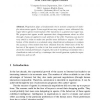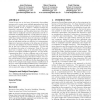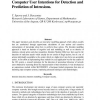27 search results - page 3 / 6 » How (not) to model autonomous behaviour |
114
Voted
AWIC
2003
Springer
15 years 5 months ago
2003
Springer
Abstract. Negotiation plays a fundamental role in systems composed of multiple autonomous agents. Some negotiations may require a more elaborated dialogue where agents would explai...
88
Voted
ECEASST
2008
15 years 19 days ago
2008
Abstract: Reo is a language for coordinating autonomous components in distributed environments. Coordination in Reo is performed by circuit-like connectors, which are constructed f...
129
click to vote
ATAL
2010
Springer
15 years 1 months ago
2010
Springer
Virtual Actors are at the heart of Interactive Storytelling systems and in recent years multiple approaches have been described to specify their autonomous behaviour. One well kno...
125
click to vote
SEC
1996
15 years 1 months ago
1996
This paper introduces and describes an innovative modelling approach which utilises models that are synthesised through approximate calculations of user actions and extensive repr...
114
Voted
CAISE
2009
Springer
15 years 7 months ago
2009
Springer
Self-contextualizability refers to the system ability to autonomously adapt its behaviour to context in order to maintain its objectives satisfied. In this paper, we propose a mod...



